Antec KUHLER H2O 920 Liquid Cooling System

Have a thick radiator, larger number of fans, software control and monitoring system and compact size made this liquid-cooling system even better? Let’s find out now!
This year North American Antec, Inc. is turning 25 years old. The company decided to celebrate this anniversary by launching a lot of new products or at least refreshing all existing series. System cases, power supply units of all categories, audio components and numerous diverse accessories has been improved or enhanced in different ways.

The cooling systems line-up also has been extended with new products. In the beginning of this year they announced Antec KÜHLER H2O 620 liquid-cooling system, and just recently they came up with a higher-performing system called Antec KÜHLER H2O 920, which will be the main hero of our today’s review.
Packaging and Accessories
The relatively large box is made of thick cardboard. There is a photo of the system on the front of the box:
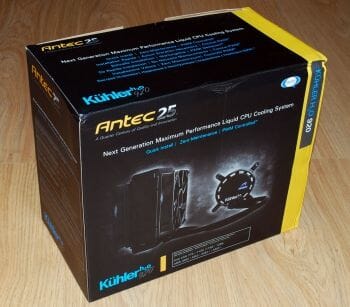
The detailed information on the back and sides of the box tells us almost everything about the system inside, including the fact that it is 7-8°C more efficient than the first-generation system (they do not specify which one in particular):
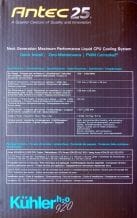
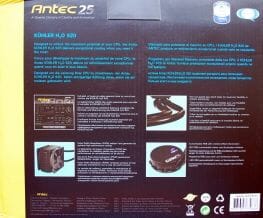
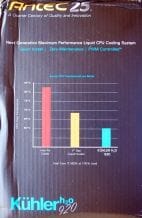
Unfortunately, the box arrived to us a little beat up, but all components inside were in perfect health due to internal packaging with individual sections for each system component.
Antec KÜHLER H2O 920 comes with two plastic backplates, two metal tension clips, a set of fan screws and fastening clips, installation guide and a CD disk with the drivers and special utility:
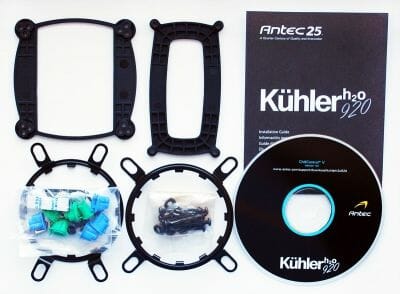
The system is manufactured in China and is priced at $109 MSRP. It comes with a 3-year warranty.
Design and Functionality
Antec KÜHLER H2O 920 is built on Asetek 570LC platform that is why there is nothing principally new about its structure:
The system is pre-filled with the coolant and sealed. It consists of a radiator with fans and a pump with the processor water block connected to the radiator with two flexible tubes:
The key difference between Antec KÜHLER H2O 920 and the previous 620 model is the twice as thick radiator – 49 mm instead of 27 mm:
Unfortunately, the major downside of the radiator still remains – the entire thing is made of solid aluminum. I am sure that it will affect not only the cooling efficiency of the system but also its life span, because the system does include a copper water block. And no matter what type and quality of anti-corrosion additives the coolant has, copper and aluminum form a galvanic pair, which will eventually lead to inevitable corrosion.
Nevertheless, the 3-year warranty from Antec should protect the users from any possible problems like that.
The radiator is 151x120x49 mm big. It consists of 9 flat channels about 1.5-2 mm thick and corrugated band soldered to it creating 1.5 mm wide cells.
Two fittings come out of the radiator and the flexible tubes are firmly pressed against them. Each tube is 11 m in external diameter and 330 mm long.
Moreover, there are threaded loops on each side of the radiator for attaching fans.The pump and water block form a single unit only 72x72x28 mm in size.
Beneath the plastic cover there is a pump with unknown declared performance. However, we know that it is built with a ceramic bearing that should last at least 50,000 hours.
The pump noise is claimed to be between 26 and 37 dBA, and its maximum power consumption shouldn’t exceed 3.1 W. The fittings on the pump can be rotated as needed, which makes it fairly easy to install the water block onto the processor and prevents the tubes from kinking.
The copper water block has multi-channel internal structure that consists of thin 6-7 mm tall ribs.There is a layer of thick gray thermal interface already pre-applied onto the water block base surface. Here is a photo of the thermal paste imprint left by the processor heat-spreader on the water block base surface.
The base is pretty well finished, even though it is not polished to mirror-chine.Compared with the 620 model, the new system not only has more fans, but each fan now has nine blades instead of seven.
Moreover, they have higher maximum rotation speed of 2400 RPM (it was 2000 RPM by Antec KÜHLER H2O 620). The minimal fan speed should be 700 RPM and the rotation speed is PWM controlled. The maximum fan airflow is declared in the specs to be at 110 CFM, and the noise – at 43 dBA. These numbers indicate that Antec KÜHLER H2O 920 will hardly be a quiet system. I have to add that the dual frictionless bearing in the fans has at least 50,000 MTBF.
Compatibility and Installation
Just like its predecessor, Antec KÜHLER H2O 920 is compatible with all contemporary platforms, but at the time of tests the system didn’t have LGA 2011 support yet, which could be nice to have, because the platform is already here and there are not that many cooling solutions for it yet. You can download the installation manual from Antec’s official web-site (PDF-file, 0.6 MB).
The first step during Antec KÜHLER H2O 920 installation is to prepare the backplate and tension clip. You need to insert special threaded bushes into the retention holes in the ends of the backplate and then put two pieces of double-sided tape on two of its sides.
This helps keep the backplate in place on the back of the mainboard.Then you insert plastic bushes with holes in them into the ends of the tension clip.Antec KÜHLER H2O 920 comes with two types of bushes: green for AMD platforms and blue for Intel platforms.
These plastic bushes are locked in the ends of the tension clip.After that you use screws that go through the PCB into the backplate to keep the tension clip in place.
However, you shouldn’t tighten these screws and install the mainboard into the system case until the water block is in place.
Before the mainboard goes in, you should arrange Antec KÜHLER H2O 92 system in the case. There must be a spot for a 120 mm fan on the system case back panel in order to fit the system perfectly.
It is attached with long screws and washers. Note that it is better to install the second fan onto the radiator after the mainboard has been successfully installed and the water block attached to it.
The water block is pressed against the processor with a tension clip. You should tighten its screws only after the water block has been pushed beneath its retention loops.
Completely assembled Antec KÜHLER H2O 920 system doesn’t take up too much room inside the system case.It is connected to the processor fan connector on the mainboard using only one three-pin cable. The fans are powered via the pump cable. Besides, you should connect a four-pin monitoring and control cable to any available onboard USB connector.
The Antec logo on top of the pump is glowing.Moreover, you can change the LED color of the logo any way you like. We will tell you how in the next chapter of our article.
Monitoring and Control
I believe that the most interesting peculiarity of the Antec KÜHLER H2O 920 system that makes it different from many other liquid-cooling products out there is the software monitoring and adjustment of major system settings. Antec came up with the drivers and a special utility for that particular matter. Yes, it is very unusual, but now even a cooling system requires drivers.
The utility is presented in a small window with four tabs. The first tab called “Dashboard” displays the coolant temperature, noise, fan and pump rotation speed.
I think the noise readings change in mathematical proportion to the fan rotation speed, because there is certainly no built-in noise meter in Antec KÜHLER H2O 920. However, the coolant temperatures do look very realistic, especially since it is a no-brainer to add a small thermal diode to the system. The same tab allows you to set the system operation mode to Extreme, Silent or Custom.
The information on the second “Graphs” tab allows you to visually control the changes in coolant temperature and fan rotation speeds.
The third tab called “Fan Control” allows setting fan rotation speeds in respect to the coolant temperature if you have previously selected Custom operation mode. You can also set up your notifications here.
Unfortunately, this utility doesn’t allow simple manual rotation speed adjustment, although it could come in very handy here.Finally, the last tab called “Settings” offers you to set up the utility itself and select a skin (you have only two choices at this time)
Here you can also pick the LED color for the Antec logo on the water block and pump unit. Note that you are not choosing from the list, but use the RGB tone chart. In other words, you can set any color you want.
Overall, this utility is indeed very functional and easy to work with. The only thing it could use for absolute perfection would be manual adjustment of the fan and pump rotor speeds.
Testbed and Testing Methodology
We performed all cooler tests inside a closed system case. Here is our testbed configuration:
- Mainboard: Gigabyte GA-X58A-OC (Intel X58 Express, LGA 1366, BIOS F5c from 09/06/2011);
- Processor: Intel Core i7-980X Extreme Edition, 3.33 GHz, 1.225 V, 6 x 256 KB L2, 12 MB L3 (Gulftown, B1);
- Thermal interface: ARCTIC MX-4;
- Graphics card: Asus Radeon HD 6770 DirectCU Silent (EAH6770 DCSL/2DI/1GD5) GDDR5 128 bit, 850/4000 MHz (with a passive heatsink from the DeepCool V4000 VGA cooler);
- Memory: DDR3 3 x 2 GB OCZ Platinum Low-Voltage Triple Channel (Spec: 1600MHz / 7-7-7-24 / 1.65 V);
- System drive: RAID-0 of 2 x Kingston V-series SNV425S2128GB SSD (SATA-II, 128 GB, MLC, Toshiba TC58NCF618G3T controller);
- Drive for programs and games: Western Digital VelociRaptor (300GB, SATA-II, 10000 RPM, 16MB cache, NCQ) inside Scythe Quiet Drive 3.5” HDD silencer and cooler;
- Backup drive: Samsung Ecogreen F4 HD204UI (SATA-II, 2 TB, 5400 RPM, 32 MB, NCQ);
- System case: Antec Twelve Hundred (front panel: three Noiseblocker NB-Multiframe S-Series MF12-S2 fans at 1020 RPM; back panel: two Noiseblocker NB-BlackSilent PRO PL-1 fans at 1020 RPM; top panel: standard 200 mm fan at 400 RPM);
- Control and monitoring panel: Zalman ZM-MFC2;
- Power supply: Xigmatek “No Rules Power” NRP-HC1501 1500 W (with a default 140 mm fan).
We overclocked our six-core processor (with its default non-lapped heat-spreader) with the multiplier set at 25x and “Load-Line Calibration” (Level 2) enabled to 4.3 GHz. The nominal processor Vcore was increased to 1.3875 V in the mainboard BIOS.
Turbo Boost and Hyper-Threading technologies were disabled during our test session. The memory voltage was at 1.5 V and its frequency was 1.38 GHz with 7-7-7-16_1T timings (Extreme profile). All other parameters available in the mainboard BIOS and related to CPU or memory overclocking remained unchanged.
All tests were performed under Windows 7 Ultimate x64 SP1 operating system. We used the following software during our test session:
- CPU Stress Test (CST) version 0.18b – to load the processor (matrix # 15, 10-12 minutes);
- Real Temp GT 3.64 – to monitor the processor core temperature;
- CPU-Tweaker 1.5 – to visually monitor temperatures and frequencies using graphics;
- Gigabyte Easy Tune 6 B11.0823.1 – to monitor voltages.
The CPU was loaded with two consecutive CST test runs with the settings as indicated above. The stabilization period for the CPU temperature between the two test cycles was about 8-10 minutes. We took the maximum temperature of the hottest CPU core for the results charts. Moreover, we will also provide a table with the temperature readings for all cores including their average values. The ambient temperature was checked next to the system case with an electronic thermometer with 0.1 °C precision that allows hourly monitoring of the temperature changes over the past 6 hours. The room temperature during our test session varied between 23.4-23.9 °C.
The noise level of each cooler was measured between 1:00 and 3:00 AM in a closed room about 20 m2 big using CENTER-321 electronic noise meter. The noise level for each cooler was tested outside the system case when the only noise sources in the lab were the cooler and its fan. The noise meter was installed on a tripod and was always at a 150 mm distance from the cooler fan rotor. The tested cooling systems were placed at the edge of the desk on a sheet of polyurethane foam. The lowest noise reading our noise meter device can register is 29.8 dBA and the subjectively comfortable noise level in these testing conditions was around 36 dBA (do not mix it up with low noise level). The fan(s) rotation speed was adjusted in the entire supported range using our in-house controller by changing the voltage with 0.5 V increment.
We are going to compare Antec KÜHLER H2O 920 against Thermalright HR-02 Macho ($40) tested with one default Thermalright TY-140 fan.
This cooler was more than enough to get a good idea of the Antec system’s cooling efficiency.
Cooling Efficiency Tests
Before we compare the cooling efficiency of Antec KÜHLER H2O 920 against that of Thermalright HR-02 Macho, let’s check out the difference between Silent and Extreme operational modes.
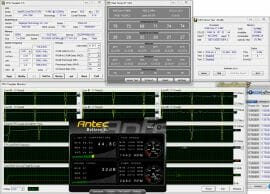
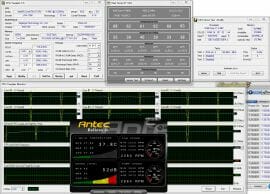
As we see, in relatively silent mode the fans of the Antec system rotated in the interval between 1380 and 1620 RPM and the maximum temperature of the hottest processor core reached 80°C. In Extreme mode the fans were always working at their maximum speed of 2300 RPM, but the temperature dropped 12°C lower and stayed at 68°C.
Obviously, the cooling efficiency of Antec KÜHLER H2O 920, just like that of other compact liquid-cooling systems, depends a lot on the quality of the radiator cooling.
All other obtained results confirm the same thing. Check out the following table and diagram (the results are sorted out in descending order).
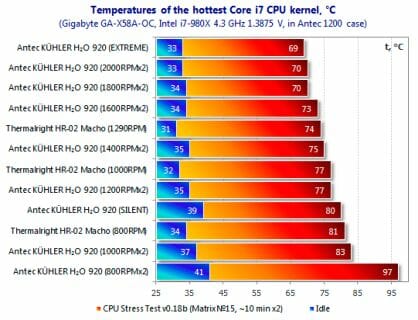
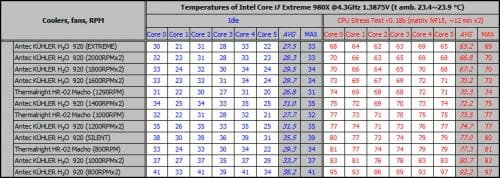
The cooling efficiency of Antec KÜHLER H2O 920 increases most impressively in the fan speed interval between 800 and 1000 RPM, when the peak CPU temperature drops by 14°C! It is easy to conclude that at 800 RPM the fans don’t have enough force to push the air flow through the thick radiator and therefore do not cool it well enough. That must be the reason why in the automatic Silent mode they never slow down below 1380 RPM under heavy load. During further increase in fan rotation speed in 200 RPM increments the temperature drops twice by 3°C and then by 2°C. With the fan rotation at 1800-2300 RPM (Extreme mode) the temperature gets only 1°C lower, which indicates that Antec KÜHLER H2O 920 doesn’t really need the fan speeds beyond 1800 RPM (for the current operational and testing conditions). We see the same from the coolant temperatures registered by Antec system.
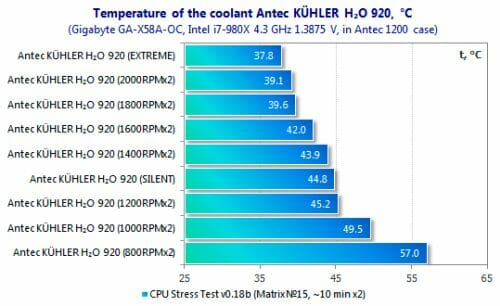
As far as comparison between the Antec cooling system and a good air-cooler is concerned, the former will be more efficient if we do not take into account eh level of generated noise, which we are going to address later in our review. At the same time, Thermalright HR-02 Macho doesn’t really look weak at all and at 800 and 1000 RPM of its single fan leaves no chances for Antec KÜHLER H2O 920. At its maximum speed of 1290 RPM Macho is as efficient as the liquid-cooling system from Antec at 1400-1600 RPM fan speed. I am sure you have already figured out which product is going to win the acoustic test at this efficiency level.
Now let’s set an even more difficult task for Antec KÜHLER H2O 920 by overclocking our test processor to 4450 MHz at 1.45 V Vcore. At 800 and 1000 RPM fan speeds the system failed to cool out CPU properly, but at 1200 RPM and higher we managed to achieve stability.
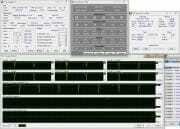
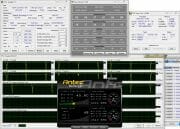
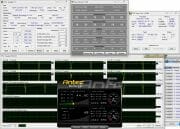
In order to overclock our processor sample to its maximum of 4500 MHz at 1.46875 V we had to speed up the fans of the Antec system to their maximum, although the peak temperature of the hottest CPU core in this case didn’t exceed 81°C.
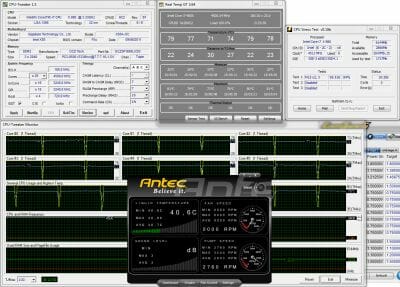
I have to say that this is an excellent result, if we leave the noise level out of it for a moment. I would also like to add that our processor overclocked a little more modestly with Thermalright HR-02 Macho – only to 4450 MHz at 1.45 V core voltage and 85°C maximum core temperature.
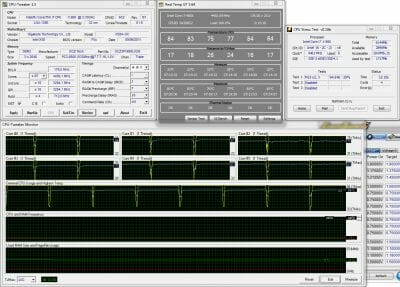
Now let’s add the results for Antec KÜHLER H2O 920 system in two default operational modes into our summary diagram and table*.
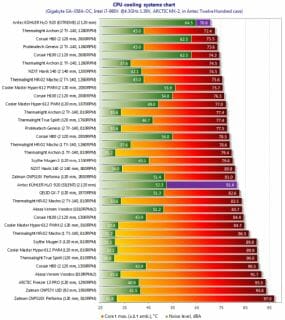
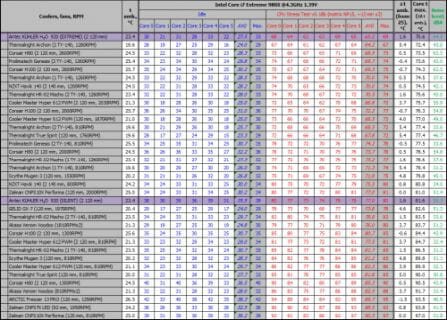
In relatively quiet mode Antec KÜHLER H2O 920 occupies a middle position, and in extreme mode it takes the lead leaving behind such competitors as Corsair H80 and Thermalright Archon with two fans. These conclusions are made without taking into consideration the generated noise levels of the testing participants.
The next diagram and table sum up the maximum CPU overclocking results for each tested cooler. Besides the CPU frequency, they also show maximum CPU temperature (taking into account the room temperature delta) and the generated noise.
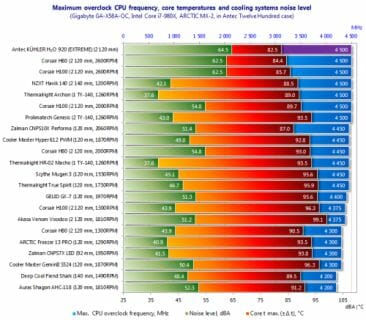
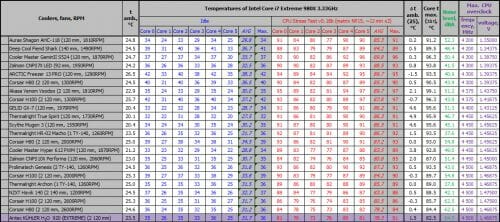
Again the compact Antec KÜHLER H2O 920 system shows the best cooling efficiency.
Acoustic Performance
We measured the noise from the Antec KÜHLER H2O 920 fans and pump and compared it against that of Thermalright HR-02 Macho. We took measurements in the entire supported speed range for both coolers according to the methodology described above. The results are summed up on the following graph.
The noise generated by the Antec KÜHLER H2O 920 fans is beyond any possible criticism. Moreover, they not only work loud at maximum speeds, but they produce very uncomfortable sound at the minimal speeds, too. Even at the moderate 1000 RPM these fans work louder than two TY-140 fans of the Thermalright HR-02 Macho cooler at their maximum 1290 RPM speed. Besides, at the minimal speed we can clearly hear the impellers beating and their motors crackling. I have to admit that these are the worst fans I have worked with so far.
As for the pump, it, on the contrary, was impeccable in terms of acoustics. You can hear it only during the first 1-2 minutes while the coolant flow hasn’t yet stabilized and the air isn’t completely gone from the impeller. After that it becomes virtually silent and doesn’t bother you at all with its barely noticeable noise of only 32.2 dBA. I can say that in terms of noise Antec KÜHLER H2O 920 components are two complete opposites: horrible fans and an excellent pump. This is a real pity.
Conclusion
As we have just seen the cooling efficiency of compact liquid-cooling systems has finally reached the efficiency level of the best air-coolers and even surpassed it to some extent. And Antec KÜHLER H2O 920 system is a great example. It just needs to make two little steps to ultimate and undisputed success.
The first thing is lowering the level of generated noise, which is totally doable and may be achieved by replacing an aluminum radiator with a copper one and using two 38 mm thick fans instead of the 25 mm thick ones. This will allow maintaining very high level of cooling efficiency at low fan speeds. The second thing is lowering the price or at least keeping it the same after the above suggested radiator and fan replacement. Otherwise, it will hardly be able to compete successfully against air-coolers.
I would also like to point out a very useful and easy to work with control and monitoring utility for Antec KÜHLER H2O 920, which could use manual fan and pump speed adjustment options. I am pretty sure that the first thing could probably be implemented in the next versions of the software, although I do not know if that could also apply to the second thing. Nevertheless, we sincerely wish Antec will improve and enhance their KÜHLER H2O 920 system on both: hardware and software levels. Today this system is highly efficient, ultimately universal, easy to install and work with, but at the same time quite noisy.
That said we are proud to award Antec KÜHLER H2O 920 with our Ultimate Innovation title.